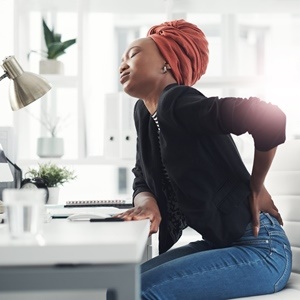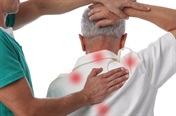
Studies have found that the incidence of lower back pain (LBP), the most common form of back pain, is highest in our 30s. Generally, the risk increases with age until 60–65, after which it gradually declines.
Are there activities that put us at greater risk for back pain? Do gender and age play a role? And what about genetics? Or should we look at a mix of genetic, physical, psychological, environmental and social factors?
We explore these questions in detail in the article entitled “Who gets back pain?”
But it’s important to understand how the following factors put you at risk:
Ageing: Discs begin to gradually deteriorate from the age of 30. With age, the discs lose moisture and start to shrink. This puts more stress on the facet joints, which become arthritic. The result is back pain.
Genetics: People who have the COL9A2 gene mutation have a 10% risk of developing sciatica. This gene plays a role in producing collagen, an important protein component of the discs.
In 2012, researchers at King’s College London identified a gene, the PARK2 gene, as a genetic cause of lumbar disc degeneration (LDD). LDD is inherited in between 65–80% of people with the condition, suggesting that genes play a key role.
Also, while 80% of scoliosis cases have no known cause, research from the University of Montreal in Canada has found a genetic link between familial cases of scoliosis and the POC5 gene.
Sedentary lifestyle: A study by the European Space Agency in Berlin, Germany (the Berlin Bed Rest Study), in which male participants spent eight weeks in bed, suggests that underused back muscles become deconditioned and deactivated, depriving the spine of support and leading to symptoms that may feel just as debilitating as an injury.
Lack of exercise may also lead to the following conditions, which may increase the risk of injury to your back:
- Muscle inflexibility: This restricts the back’s ability to bend and rotate.
- Weak back muscles: This increases the load on the spine and the risk of disc changes.
- Weak stomach muscles: This increases strain on the back and causes the pelvis to tilt abnormally, resulting in biomechanical overload.
Trauma: Heavy lifting, whiplash or other injuries can damage and inactivate the support muscles in your back that work together to support the vertebral and pelvic structure.
This increases the risk of long-term back pain, as you’re more likely to suffer sprains, or damage to the discs or other tissues in the back.
However, the Berlin Bed Rest study shows that only between 10–15% of cases of back pain begin with such injuries.
If you’ve been sitting or lying in bed all week, and suddenly mow the lawn, move furniture, lift heavy objects (using straight legs or a bent back), or simply move suddenly, your deactivated muscles may be unable to adequately support the spine.
This may result in a painful back injury if the muscles are over-stretched or torn, or a ligament tears.
Being overweight: This puts stress on the joints and pressure on the vertebrae and discs. A large belly pulls the spine forward and out of alignment, increasing the risk of back strain.
Sleeping on the wrong mattress: A study in The Lancet found that people who chose a medium-firm mattress showed fewer signs of back issues three months after purchasing their mattresses compared to people who bought firm mattresses. Follow Goldilocks’ advice: don’t have a bed that’s too hard or too soft, but rather just right.
Smoking: Cigarette smoking accelerates degeneration of the lower spine. Nicotine restricts blood flow to vertebrae and disks, so they may age and break down more quickly. Smoking may also interfere with the body's ability to absorb and use calcium, leading to osteoporosis-related bone and back problems.
Being depressed, anxious and/or stressed: A study published in Arthritis Care and Research suggests that people who suffer from depression have a 60% greater chance of developing LBP in their lifetime than those who don’t. This emphasises the importance of understanding the bio-psychosocial interpretation of pain, that is, how biological, psychological and social factors interact to help us understand the cause and outcome of disease and wellness.
Pregnant women: Pregnancy makes women prone to back pain due to the shifting of abdominal organs, the forward redistribution of body weight, and the loosening of ligaments in the pelvic area prior to delivery.
Repetitive work: Certain types of repetitive work, such as factory work or truck driving, put you at risk of back pain. Risky activities include lifting, forceful movements, bending and twisting into awkward positions, repetitive movements, and vibration (such as the vibration that occurs with long-distance truck driving).
Improper body mechanics during sporting activities, e.g. a jerky golf swing or incorrect use of exercise equipment, can damage the back. Cyclists often experience LBP, which can often be resolved by adjusting the angle of the bicycle seat.
Some research suggests that, over time, high-impact sports activities such as rugby and aerobics may increase the risk for degenerative disc disease. Hyperextension of the spine, as in gymnastics and cricket (especially in the case of bowlers), may lead to stress fractures (spondylolysis).
Low levels of vitamin D: A clinical review of the management of lower back pain published in the Annals of Family Medicine cites a number of studies that show that individuals who experience persistent, non-specific musculoskeletal pain are deficient in vitamin D, and that supplementing with the vitamin can reduce pain.
One leg shorter than the other: This can put you at risk of chronic lower back pain, as even a slight imbalance can cause your spine to curve to the short side when you walk or run. Eventually, the bend puts painful pressure on your disks. A difference of up to 2cm is, however, unlikely to cause hip problems.
High-risk workouts
Running
Running is a high-impact exercise, and the faster you run, the harder your feet hit the ground.
This repetitive jarring is very hard on the joints and spine. A study published in the British Journal of Sports Medicine found that a novice runner’s spine can shrink by several millimetres after a 6km run, (25 km for trained runners) and that this shrinkage is directly proportionate to running speed.
Although the relationship between spinal shrinkage and spine pain isn’t fully understood, these results show just how much stress running can put on the spine. If you experience chronic back pain, running may not be the best form of exercise for you.
Sit-ups
Pulling on your neck while crunching hurts the upper back, while the lower back can get hurt when your hip flexors pull on the spine to raise your upper body off the ground.
While sit-ups used to be a favourite among gym instructors, it’s worth remembering that it only works 20% of your abdominal muscles and that it puts a huge strain on the back.
Reviewed by general practitioners Dr Lienka Botha and Dr Suzette Oelofse, FX Health. April 2018
References:- Hoy D. et al. The epidemiology of low back pain. Best Pract Res Clin Rheumatol. 2010 Dec;24(6):769-81. doi: 10.1016/j.berh.2010.10.002.- Kings College London, New back pain gene identified in largest genetic study of its kind.- New Scientist. Unused back muscles switch themselves off. - Shunmoogum A. Patten et. al. Functional variants of POC5 identified in patients with idiopathic scoliosis. J Clin Invest. 2015 Mar 2; 125(3): 1124–1128.- Michiel W. P. Bleeker et. al. Vascular adaptation to deconditioning and the effect of an exercise countermeasure: results of the Berlin Bed Rest Study. Journal of Applied Physiology. Vol. 99, No. 4.- Pinheiro MB et al. Symptoms of Depression and Risk of New Episodes of Low Back Pain: A Systematic Review and Meta-Analysis. Arthritis Care Res (Hoboken). 2015 Nov;67(11):1591-603. doi: 10.1002/acr.22619.- P Leatt et al. Spinal loading during circuit weight-training and running. Br J Sports Med. 1986 Sep; 20(3): 119–124.- Kovacs FM et al. Effect of firmness of mattress on chronic non-specific low-back pain: randomised, double-blind, controlled, multicentre trial. Lancet. 2003 Nov 15;362(9396):1599-604




 Publications
Publications
 Partners
Partners












